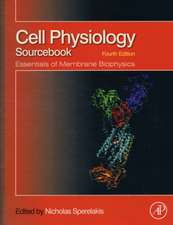The Molecular Theory of Radiation Biology: Monographs on Theoretical and Applied Genetics, cartea 5
Autor K. H. Chadwick, H. P. Leenhoutsen Limba Engleză Paperback – 8 dec 2012
Din seria Monographs on Theoretical and Applied Genetics
- 20%
 Preț: 559.63 lei
Preț: 559.63 lei - 18%
 Preț: 985.38 lei
Preț: 985.38 lei -
 Preț: 383.71 lei
Preț: 383.71 lei - 20%
 Preț: 555.35 lei
Preț: 555.35 lei - 15%
 Preț: 641.38 lei
Preț: 641.38 lei - 15%
 Preț: 644.30 lei
Preț: 644.30 lei - 15%
 Preț: 643.65 lei
Preț: 643.65 lei - 15%
 Preț: 640.06 lei
Preț: 640.06 lei - 15%
 Preț: 649.71 lei
Preț: 649.71 lei - 15%
 Preț: 639.41 lei
Preț: 639.41 lei -
 Preț: 387.20 lei
Preț: 387.20 lei - 15%
 Preț: 642.68 lei
Preț: 642.68 lei - 15%
 Preț: 639.25 lei
Preț: 639.25 lei - 15%
 Preț: 637.59 lei
Preț: 637.59 lei - 15%
 Preț: 636.30 lei
Preț: 636.30 lei - 15%
 Preț: 644.82 lei
Preț: 644.82 lei - 15%
 Preț: 643.16 lei
Preț: 643.16 lei - 20%
 Preț: 558.52 lei
Preț: 558.52 lei - 15%
 Preț: 639.08 lei
Preț: 639.08 lei
Preț: 648.42 lei
Preț vechi: 762.85 lei
-15% Nou
Puncte Express: 973
Preț estimativ în valută:
124.11€ • 134.86$ • 104.32£
124.11€ • 134.86$ • 104.32£
Carte tipărită la comandă
Livrare economică 21 aprilie-05 mai
Preluare comenzi: 021 569.72.76
Specificații
ISBN-13: 9783642815218
ISBN-10: 3642815219
Pagini: 404
Ilustrații: XVII, 377 p. 15 illus.
Greutate: 0.64 kg
Ediția:Softcover reprint of the original 1st ed. 1981
Editura: Springer Berlin, Heidelberg
Colecția Springer
Seria Monographs on Theoretical and Applied Genetics
Locul publicării:Berlin, Heidelberg, Germany
ISBN-10: 3642815219
Pagini: 404
Ilustrații: XVII, 377 p. 15 illus.
Greutate: 0.64 kg
Ediția:Softcover reprint of the original 1st ed. 1981
Editura: Springer Berlin, Heidelberg
Colecția Springer
Seria Monographs on Theoretical and Applied Genetics
Locul publicării:Berlin, Heidelberg, Germany
Public țintă
ResearchCuprins
1. Quantitative Radiation Biology.- 1.1 Radiation in Society.- 1.2 Radiation Biology: the Interdisciplinary Discipline.- 1.3 The Importance of Cellular Biology.- 1.4 The Quantitative Analysis of Radiation Action: a Brief Historical Review.- 1.5 Desiderata for a Quantitative Theory of Radiation Biology.- 2. The DNA Molecule and Its Role in the Cell.- 2.1 Introduction.- 2.2 The Structure and Dimensions of the DNA Molecule.- 2.3 Base Sequences and the Genetic Code.- 2.4 DNA Replication.- 2.5 DNA in Chromosomes.- 2.6 The Diploid Cell, Mitosis and Meiosis.- 2.7 Radiation-Induced Damage to DNA.- 3. The Molecular Model for Cell Survival Following Radiation.- 3.1 Historical Development.- 3.2 The Philosophical Framework of the Model.- 3.3 The Induction of DNA Double Strand Breaks by Radiation.- 3.4 The Relationship Between Cell Survival and DNA Double Strand Breaks.- 3.5 The Cell Survival Curve.- 3.6 Variation in the Survival Curve Through the Cell Cycle.- 3.7 Asynchronous Cell Populations.- 3.8 The Experimental Correlation Between Cell Survival and DNA Double Strand Breaks.- 3.9 Summary.- 4. Chromosomal Aberrations.- 4.1 Introduction.- 4.2 The Nature and Yield of Chromosomal Aberrations.- 4.3 The Classical and Exchange Theories of Radiation- Induced Chromosomal Aberrations.- 4.4 The Molecular Theory of Radiation-Induced Chromosomal Aberrations.- 4.5 Complex Chromosomal Rearrangements.- 4.6 Gene Transplantation.- 4.7 Summary.- 5. Somatic Mutations.- 5.1 Point and Chromosome Mutations.- 5.2 Some Molecular Mechanisms Which Could Give Rise to Mutations from DNA Double Strand Breaks.- 5.3 Mutation Frequency Dose Relationships.- 5.4 The Analysis of Experimental Data.- 5.5 Two Mutations in the Same Cell Population.- 5.6 The Mutation Spectrum.- 5.7 Summary.- 6. Correlations.- 6.1 Introduction.- 6.2 The Survival-Survival Correlation.- 6.3 The Survival-Chromosomal Aberration Correlation.- 6.4 The Correlation Between Different Chromosomal Aberrations.- 6.5 The Correlation Between “Normal” Chromosomal Aberrations and “Complex” Chromosomal Aberrations.- 6.6 The Correlation Between Survival and Somatic Mutation.- 6.7 The Correlation Between Two Different Mutations Induced in the Same Cell Population.- 6.8 The Peak Incidence - an Implied Correlation.- 6.9 What Do the Correlations Mean?.- 7. Repair.- 7.1 Introduction.- 7.2 The Repair of DNA Single Strand Breaks and the Dose Rate Effect.- 7.3 The Repair of DNA Single Strand Breaks and the Effect of Dose Fractionation.- 7.4 The Repair of DNA Double Strand Breaks and the Post-Irradiation Effect.- 7.5 The Difference Between Sub-lethal Damage Repair and Potentially Lethal Damage Repair.- 8. Radiation Quality.- 8.1 The Differing Shape of Dose-response Relationships.- 8.2 A Qualitative Assessment of the Dependence of the ?-Coefficient on Radiation Quality.- 8.3 A Qualitative Assessment of the Dependence of the ?-Coefficient on Radiation Quality.- 8.4 How Constant is the Value of RBEo?.- 8.5 The Size of the Target.- 8.6 A Calculation of the Dependence of the a- and ß- Coefficients on Radiation Quality.- 8.7 Summary.- 9. Cancer.- 9.1 Introduction.- 9.2 Somatic Mutation and Cancer.- 9.3 The Malignant Cell.- 9.4 Radiation-Induced Cell Transformation.- 9.5 Extrapolation to Animals and Man.- 9.6 Conclusion.- 10. Genetic Effects.- 10.1 Introduction.- 10.2 The Induction of Dominant Lethal Mutations.- 10.3 Correlations Between Different Genetic End Points.- 10.4 The Induction of Translocations in the Spermatogonia of the Mouse.- 10.5 The Induction of Specific Locus Mutations in the Mouse.- 10.6 Conclusions.- 11. Synergistic Interaction.- 11.1 Introduction.- 11.2 Theoretical Development.- 11.3 Agent Toxicity.- 11.4 Agent Dosimetry.- 11.5 Experimental Examples of Synergism.- 11.6 General Discussion.- 12. Implications.- 12.1 Radiological Protection.- 12.2 The Chemical Hazard.- 12.3 Radiation Therapy.- 12.4 Plant Mutation Breeding.- 12.5 Postscript.- References.- List of Abbreviations.










